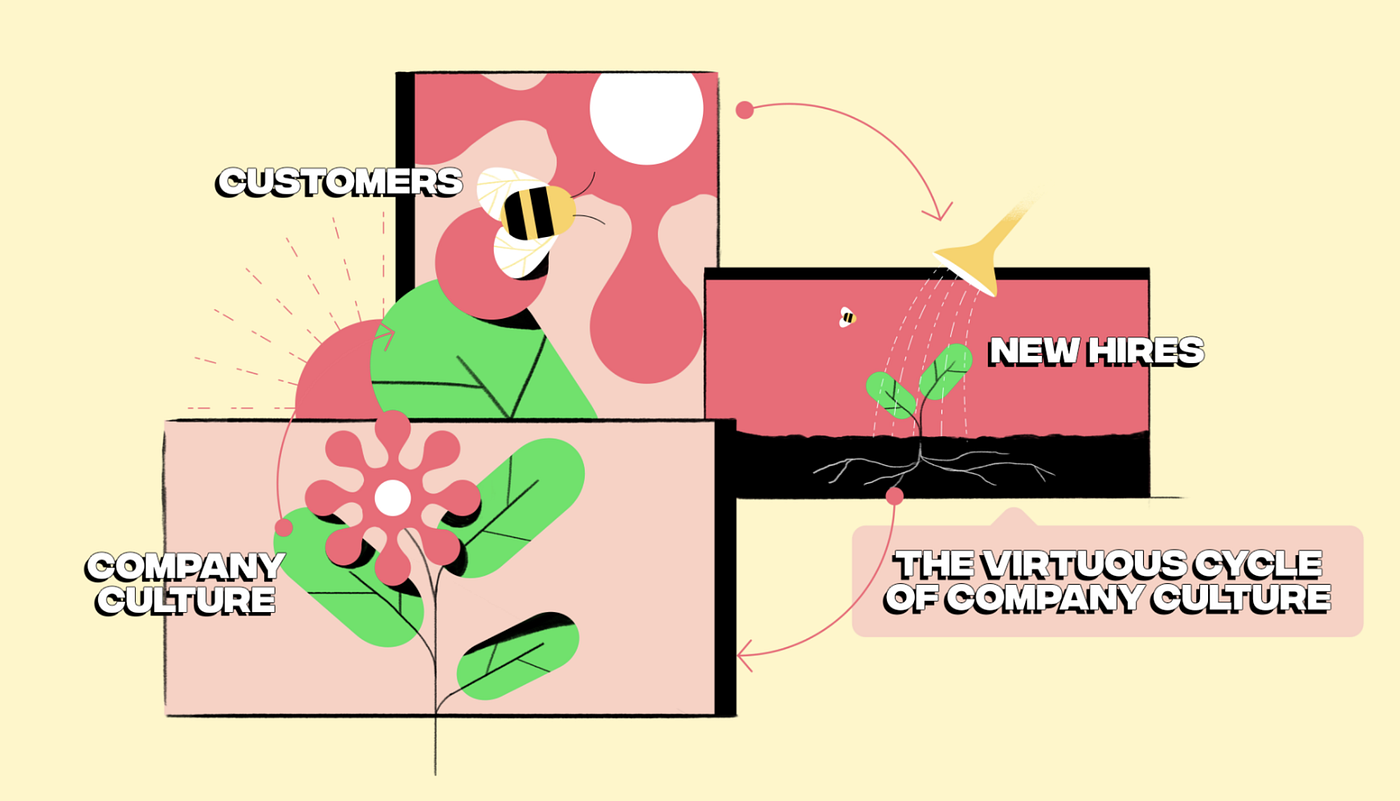
Company Culture is gaining more and more attention, but a company’s culture is way more than ping-pong tables and salad bars. It translates into who you attract towards your business, both as employees and as customers. Company culture can make or break you. It is what differentiates stronger brands, and market leaders from brands you won’t remember in a month.
Company culture is the heart and the brain of an organization.
Culture happens anywhere where people spend time together: from nations to football fan clubs, to groups of friends. So, of course, companies have cultures as well, and cultural lives in the people that form a company. Therefore, who you hire has a huge impact on your company’s culture.
Companies with purpose-driven cultures have happier, more creative teams, and higher retention. Purpose-driven culture means that the people that form the organization see their work as meaningful, able to make a difference, and worthy of their involvement and engagement. This requires a unique company culture; one that is aligned to the values and to the purpose of the organization, and one is fully encompassing everything that is your brand.
…
So, what is company culture?
Organizational culture is the way people feel about the work they do; it is how a company does whatever they do, it is what the organization values, the way it solves problems, it is ….
- Shared values
- Rituals/Habits
- A shared purpose
Culture is the core of your company. The culture of your company is what keeps it in check. It was there when it all started, maybe when you were an organization of only one; it was thereafter you hired your first employee and will be there when you go global.
Strong and effective culture can’t be copied, it has to be created especially for your company.

Patagonia is a great example of a culture that was designed with its values in mind. Patagonia’s higher purpose is to save our planet, and as such, they look for employees that love nature and its preservation. How does this reflect on their company culture? They have an employee handbook called “Let My People Go Surfing”, in which they recognize that if they want their employees to stay in love with nature, they need the time to go and be with nature, hiking, climbing, or catching waves.
Purpose-driven culture requires constant revision and evolution. In order to do this, organizations must commit to hiring for culture-add rather than culture-fit.
…
Culture-add vs. culture-fit
Culture-add means recruiting people that will bring something new and needed to your company’s culture. Culture-fit, on the other hand, means hiring someone that matches perfectly your culture today. Sounds tempting, right? Of course, you want to hire people that share your values and want to see your mission come to life. But you also want to hire people that will enrich your culture.
When thinking about putting a team together, it is normal to wish to assemble a team of people that are similar, people that work in the same ways, and that are like-minded. This will result in a very homogenous team, and probably at the beginning in a very efficient one. But with time, the team will lose drive, will be unable to innovate and its creativity will decrease.

Culture-add means that you are looking for people that will enrich your company’s culture.
People that will add to your company’s culture need to value the standards and share the values your organization was built on. Yet, they should also bring diversity that positively contributes to the company. Culture-add hires will challenge your culture, but in the end, will make it stronger.
That can only happen if you have a diverse team with a common goal, people coming from different backgrounds, with different stories, and different ways of getting things done.
…
Everyone on board the culture train
Culture can make or break your relationship with customers and with employees.
Having a clear purpose will attract talent to your organization, but is not enough to make them stay. Talented employees have to be on board with the purpose, their work needs to be, and feel, meaningful. The same applies to customers. Your purpose will bring them to your door, but your culture will invite them to stay, creating loyalty.
Engagement and empowerment ensure culture. No matter how amazing the culture of your organization is, it needs people to actively bring that culture to everything they do, and that can only happen with engaged and empowered employees.
Creating a strong company culture
Having a strong culture permeates into your brand. Just as much as customers can feel it; future talent will be drawn towards your company because of your culture and, thereafter, reinforce it further.
Your brand will reach various demographics, and you have to retain and attract people that speak to, and of, those demographics. Mentorship, and getting them into leadership roles will bring that diversity into every room and every meeting at the office.

Enriching your culture means hiring diversity. Companies with highly diverse teams are 35% more likely to outperform their peers. Culture-add requires changing the mindset when recruiting; looking for candidates that come from all walks of life, that can bring something new to table, and that can boost your culture and values.
Let’s take Fairy (the dish soap) as an example, they renamed their brand “Fair” during pride month to show their support to the LGBTQ+ community. They also commissioned a report on the issues faced by the LGBTQ+ community; but most importantly, team members of the LGBTQ+ community wrote this report. Their culture celebrates diversity, their hiring reflects that diversity, and those diverse teams enhance their culture.
…
Culture is an inside and an outside job.
Now more than ever, alignment between brand and culture is a must. Within your company, there should be one coherent narrative between culture, product, and brand. Customers want to buy the company’s culture when they purchase their product, when they join your brand.
Once you communicate and impregnate your culture into your product, your community –customers, potential customers, employees, and potential employees– will take note of that and your culture will get them to act as well. Customers will purchase and become loyal to your brand by engaging with it. In the case of employees, by bringing new and creative ideas to the table, while also achieving increased retention of employees.

…
Culture will do the recruiting for you.
All potential employees are consumers before (and hopefully after) they become part of the team. A strong company culture that comes across in your product and the way your company interacts with clients will be what draws people to apply for open positions at your organization.
In fact, companies that share their culture with their community, and make it part of everything they do, have a 31% higher InMail acceptance rate. Meaning, that potential employees are more likely to apply or respond to jobs in your organization if they already know about your culture, and feel they can trust you as an employer.
This is called Talent Brand.
Bringing the employee experience to the center of your culture and your brand. According to LinkedIn, companies in their network with a strong Talent Brand Indexeven have to spend 43% less money in their recruiting process.
If your company has a beloved product, an admirable brand, and a culture that values employees and is committed to achieving a higher purpose, who wouldn’t want to send their CV to you?
…
What goes around comes around
Here is where the virtuous cycle of company culture comes full circle. A strong company culture that is on-brand, purpose-driven, and has employees and consumers at the center of everything they do; will become a huge selling point for your product. Your product will share the story of your company culture and its purpose. And just like that, talent will start knocking on your door. This talent will not only fit with your culture, but will improve it, enrich it, and add to it.

Your culture will become stronger, more diverse, and the cycle will repeat itself.
